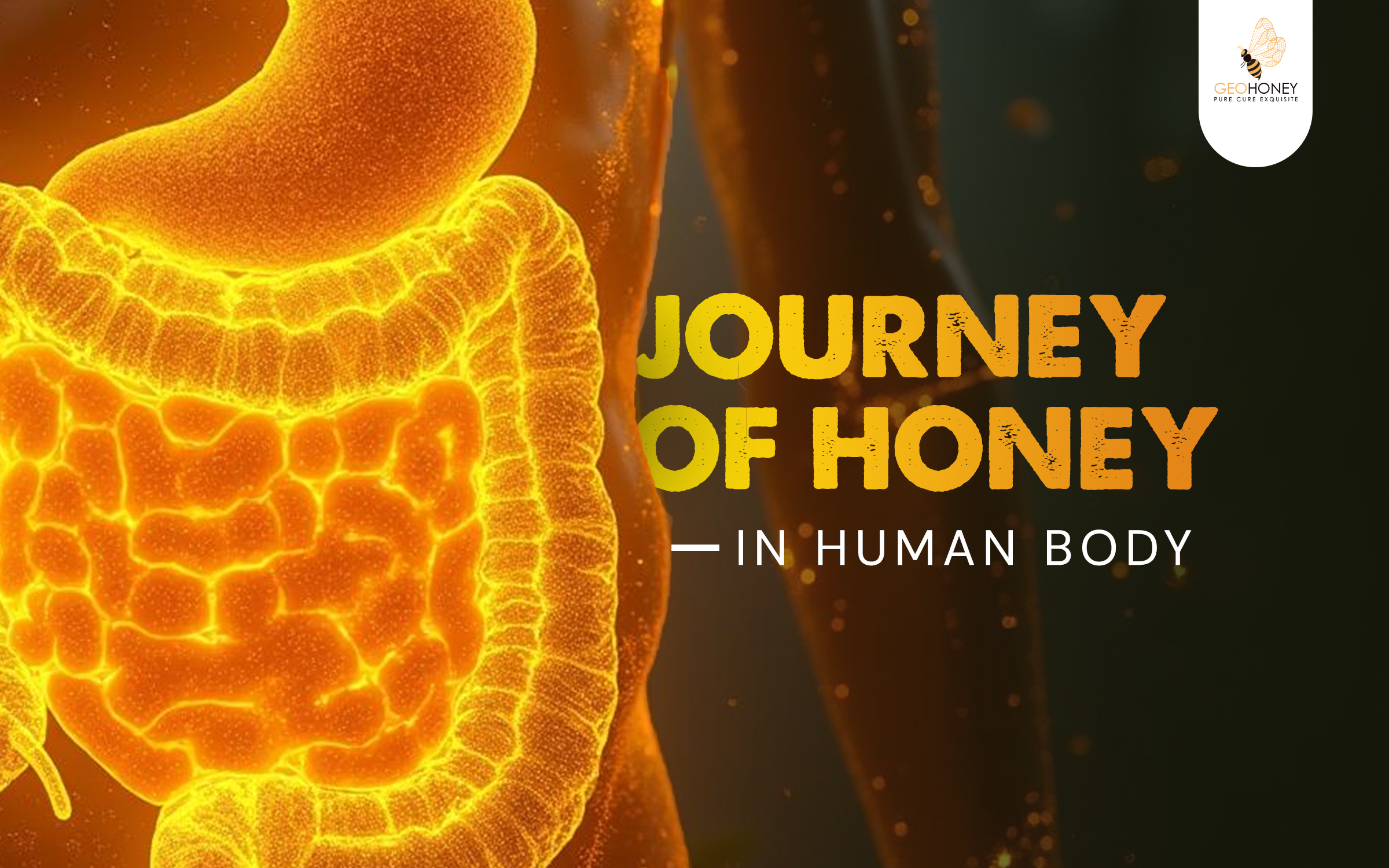- Tokyo: 11:41
- Singapore: 10:41
- Dubai: 06:41
- London: 02:41
- New York: 21:41
Journey of Honey in the Human Body

Honey is a treasured natural sweetener that humans have been consuming in one way or another for thousands of years. Apart from boasting a sweet flavor, honey is also known to have many benefits for our physical and mental health and wellbeing.
Honey has been a key ingredient in countless culinary recipes and natural medicine. But have you ever wondered how the human body processes this sweet and savory delicacy?
“Honey is rich in antioxidants, vitamins, and minerals that enhance your health in every step during its journey in our bodies.”, says the founder of Geohoney and the CEO of BA Barry Group, Mr. Basem Barry.
This blog explores the way honey travels through and nourishes your whole body in different ways. So, without wasting any time, let’s jump right ahead and see what the amazing journey of raw honey in our bodies entails.
Ingestion: The Journey Starts at the Mouth
Transportation to The Esophagus
The Role of the Stomach
Nutrient Absorption at the Small Intestine
Processing in the Liver
Honey Reaches the Bloodstream
Honey in the Large Intestine
Elimination
The following is a detailed account of the journey of honey inside the human body. The honey’s journey starts at the mouth right after you take a few teaspoons of it. First, it comes across your tastebuds, which instantly detect its sweet and rich flavor. The sweetness of honey comes from its simple sugar, i.e., glucose or fructose content. Tastebuds send this signal to the brain, which triggers a sense of pleasure accompanied by elevated energy levels. At this point, the honey mixes with saliva, triggering the initial carbohydrate digestion, usually with the help of amylase, which is a key digestive enzyme. Amylase is responsible for breaking complex carbohydrates into simple sugars, which facilitates their digestion. After initial processing inside the mouth, you swallow the honey, which leads us to the next stage of its journey. The honey you swallow enters the esophagus, where it is moved downward by involuntary muscle contractions (peristalsis). This smooth movement guides the organic honey to the stomach without triggering active digestion at this stage. From the esophagus, honey reaches the stomach where it reacts with gastric juices, including HCL and digestive enzymes like pepsin, amylase, and gastric lipase, which promote protein breakdown and fat digestion. The broken-down honey mixes with other foods and digestive fluids inside the stomach. At this stage, honey’s natural components like glucose oxidase become active, which triggers the release of hydrogen peroxide. This compound gives honey its antibacterial features that work to enhance the performance and efficiency of your digestive system. The small intestine is where honey’s nutrients are absorbed into the body. First, the simple sugars like glucose or fructose are absorbed through the intestinal walls, from where they become a part of your bloodstream. Honey’s antioxidants, vitamins (B complexes), and minerals are also absorbed in the small intestine. The honey’s prebiotic components are also separated and absorbed at this stage, which proves effective in the steady growth of the healthy bacteria inside your gut. The honey that enters your bloodstream does not cause sudden or intense sugar spikes like regular sugar. This is because honey has more fructose than glucose, which gives it a lower glycemic index. This gives you a sustained energy boost without any sugar highs or other side effects. The absorbed fructose content of the honey is mainly processed by the liver. The liver converts this fructose into fats, glucose, and glycogen. Glycogen is your body’s storage of fructose or simple sugar. Honey has natural sugars that can stimulate glycogen storage. If your body needs energy, the glucose or fructose is released to the bloodstream to meet this demand. This proves especially helpful for athletes or people engaged in intense physical activities for extended periods. The glucose that reaches your bloodstream is used to provide fuel to key organs like the brain, heart, and muscles. Apart from glucose, other bioactive components of honey, including some antioxidants, also enter your bloodstream. These components prevent inflammation and enhance immune response. This makes honey an extremely valuable dietary choice for athletes who often face fatigue or low blood sugar levels due to intense and prolonged physical activities. From the small intestine, the broken-down monofloral honey components reach the colon or large intestine. These are undigested components of honey, like complex sugars, pollen, or enzymes. These components react with the gut microbiota, effectively serving as prebiotics. The prebiotics contribute to the growth of beneficial gut bacteria, which leads to a much healthier gut functionality. Finally, the indigestible remnants of the honey or waste materials are excreted from your body. This happened through the rectum or anus organs which are parts of the body’s regular waste expulsion system. This way, our body utilizes every drop of the pure honey and discards what it doesn’t need, giving you the necessary energy boost without any side effects. Honey’s incredible journey through the human body is marked by the nourishment of your entire being. From regulating your blood sugar levels to rejuvenating your cells and from enhancing digestion to boosting energy levels, honey literally ensures your body is always well protected and nourished. Honey, when consumed in moderation, can keep you physically fit and mentally agile. This superfood can thus be an amazing addition to your regular diet and healthy lifestyle. You can have it first thing in the morning to get your daily dose of energy or right before bed for a calmer sleep. So, the next time you have this amazing natural sweetener, take a moment to appreciate how it moves through your entire body, nourishing and replenishing every organ that it touches. Visit us at Geohoney to explore our premium quality raw monofloral honey products to enjoy both a superior physical as well as mental health without sacrificing on sweetness. Ingestion: The Journey Starts at the Mouth
Transportation to The Esophagus
The Role of the Stomach
Nutrient Absorption at the Small Intestine
Processing in the Liver
Honey Reaches the Bloodstream
Honey in the Large Intestine
Elimination
Conclusion



